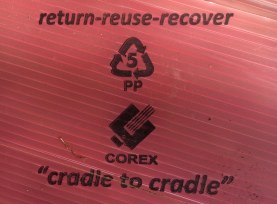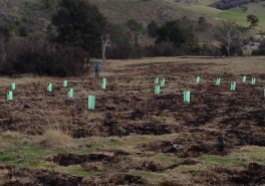
It’s an embarrassment that when I see litter in our paddocks. That’s because it’s usually my own: one of my tree guards that has blown off and landed in the creek, or among the ti-tree, or strung up against a barbed-wire fence.
But collecting them again is the easy part. The problem is what to do with the hundreds of covers that stay on, doing their job, and then need to be recycled?
If you want a seedling tree or shrub to survive out in a paddock, you generally have to guard it. Guard it against rabbits, frost, loss of moisture and so on.
Over the years we’ve tried all sorts of protection – from star pickets and mesh, teamed with water-filled beer bottles (worked against rabbits, but were not great against frost and moisture loss), then to big floppy plastic “grow tubes” which were held up by three wooden stakes, (a lot better against moisture loss and frost, but needed a fence to protect against the sheep). Then to the recycled wax-cardboard milk cartons, which were smaller, easier to carry but not as much protection. They mostly disintegrate in a year. Since 2011 we’ve been using corflute (fluted multi-wall polypropylene) in larger sizes that protect the growing plants for longer. It’s sturdy against rabbits, frost and help with moisture retention, and is easy to put up, only needing one stake.

The ones we use are a delightful pink, from Global Land Repair, which has the extra benefit of showing up on the hillsides so that I can admire my plantings from a distance. The pink is also supposed to encourage photosynthesis and rapid root growth. One batch of covers faded rather quickly, and it did seem to me that the trees planted in those ones struggled a little more, but I may just have been bitter because I couldn’t see them on the hillside.
We’ve tried several different sizes and settled on a medium-sized Pioneer Plus. Some of the earlier ones we tried were bigger, but to stop them flying away on the wind, they had holes drilled in the sides, which the branches grew through and were tough to remove. The large ones without wind-holes are difficult to get a grip on to remove, and heavier to carry up steep hills, not to mention the time I asked my assistant Trent to put out 200 of them some days before we started planting. When the weather turned windy, they took off like kites and turned up hundreds of metres away festooned like giant pink flowers on a patch of rose briars. Matt Kilby from Global Land Repair is very keen on having wider tops to allow branches to spread naturally, but I find this just allows more access to the kangaroos to nibble it down to a stump, so I prefer his straight-sided ones when I can get them.
It was interesting to compare the guards used by Greening Australia, which are a conservationist-attracting pale green, ready glued into a straight triangular tube shape. When the Green Team planted our problem paddock on Adnamira they used rip lines plus the covers, very healthy plants, a rather splintery softwood stake, a staple to stop them flying away, and water. That was much quicker than our twelve step planting program (hole or rip-line, plant, mycorrhizae, tree-starter minerals, coir mulch mat, cover, stake, extra wood-chip mulch, and water – okay that’s only nine steps, but it feels like twelve).
I no longer spray my rip lines or planting hole locations before I put the trees in, because it seemed to cause more trouble than it was worth. Instead I use a coir mat and lots of heavy mulch to suppress surrounding grass growth afterwards. That has the extra benefits of keeping moisture in the ground and breaking down into nutrients for the trees.
Even after seeing Greening Australia in impressive action I still like my pink covers, mainly because they are easier to reuse. The Global Land Repair covers also have a foot that bends up. Once installed they don’t usually blow away, so don’t need a staple. The hardwood stake they’re designed for is much less splintery, and stronger, so I often get to re-use that as well, if it’s not gripped by the ground so hard I can’t remove it. If the tree has grown quickly, usually a wattle, it’s possible to unfold them to get them off, rather than having to cut down the side or squash the new branches through the original small hole.
A weak point in all corflute covers is the edge of the hole where the stake goes through, which tends to tear to the side. I’ve tried using duct tape to repair that, but it tends to melt and fall off over time.
Most of my pink covers get used two to four times. Each year I plant about a thousand trees, and recover about 6-700 usable covers. If the plants grow slowly, I leave many on for two to three years. Over the years in the sun they fade a little, and after four or five years they get brittle and have to be retired.
It seems a shame to simply send them to landfill. I supplied a few torn ones to my neighbour Cathy to see if they’d work as flaps on wombat burrows, but they were too soft. In the end she preferred pieces of chicken wire that the wombat would see through more easily, and receive its dose of anti-mange medicine calmly. An angry wombat is something to avoid.
 I asked my brother Andrew, who is in the plastics industry, whether corflute could be recycled and he told me it was polypropylene, which is a Group 5 recyclable plastic, “It’s miscible” he said “Miscible, not mixable, for some reason that’s the term they use, but it means it can go back in the mix with both group 5 and group 6 plastics.” As I hung up he was still muttering “miscible, what a stupid word”.
I asked my brother Andrew, who is in the plastics industry, whether corflute could be recycled and he told me it was polypropylene, which is a Group 5 recyclable plastic, “It’s miscible” he said “Miscible, not mixable, for some reason that’s the term they use, but it means it can go back in the mix with both group 5 and group 6 plastics.” As I hung up he was still muttering “miscible, what a stupid word”.
I called Matt Kilby from Global Land Repair and he agreed to get the recycling triangle and number 5 printed on the future batches. On that basis I managed to get some into the recycling containers at the Murrumbateman tip, although the manager was doubtful. .
The Greening Australia ones don’t have the recycling symbol. I don’t want to re-use them because I’d have to buy the fatter, splintery stakes and a stapler, and I prefer my pink covers. So I called Graham, one of my contacts at Greening Australia, and asked what I should do? I discovered that they were happy to take back any that were re-usable (note to self – take a screwdriver to get the staples out without ripping the corflute). That covered about half of them.
He said they’d had a lot of trouble trying to find somewhere to send the unusable ones, and the recycling stations in Canberra wouldn’t take them, with or without a recycling symbol.
After talking to Graham I did a bit more internet surfing and found that Corex in Melbourne will take back pallets of clean corflute for recycling at no cost from New South Wales. That’s interesting. Maybe we can get an annual program going to collect it up and send it back????
In the meantime, Craig wanted the buckets of broken covers out of the shed, so I took them to Murrumbateman Recycling Station and hallelujah, they took them because the top one showed the recycling triangle.  Together me and the guy on duty stuffed a full bag of Number 5 PP. I hope they go to a good home.
Together me and the guy on duty stuffed a full bag of Number 5 PP. I hope they go to a good home.









BioGone can provide these in a landfill-biodegradable format. They should be recycled as much as possible but at the end when they would be discarded, the microbes in a landfill would digest them away over a few years.
LikeLike
Hi Ross that sounds interesting. I’ll have to have a look at that. I do like compostable rather than biodegradable plastics (which I think you’re describing) because “degrading” in many cases just means breaking down into tiny pieces that get into the water systems.
LikeLike
Ah, I see, from reading your website that this is something different. I guess the question would be, how would they survive when surrounded by dirt and mulch, as we do for one to three years? It wouldn’t be helpful if they broke down at that point. Hmmm.
LikeLike
Wonderful read my friend!
LikeLike
Lovely to hear from you!
LikeLike
Great piece – and it’s surprising that the covers are not more easily recyclable! Perhaps the ACT gov might have a program?
LikeLiked by 1 person
No, there’s no program. But Corex in Melbourne have one, which works.
LikeLike